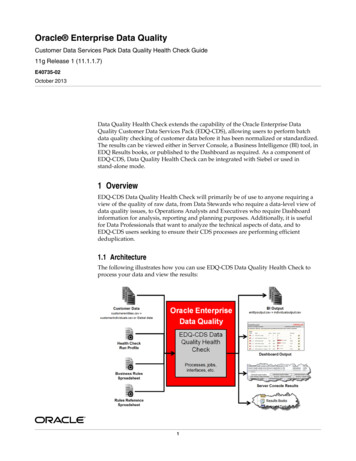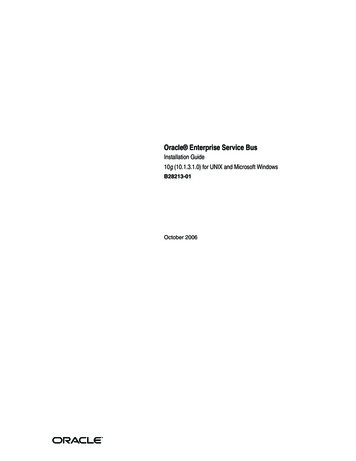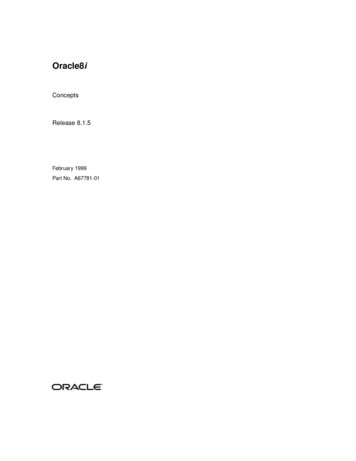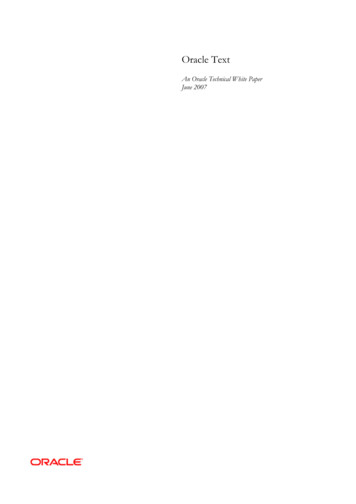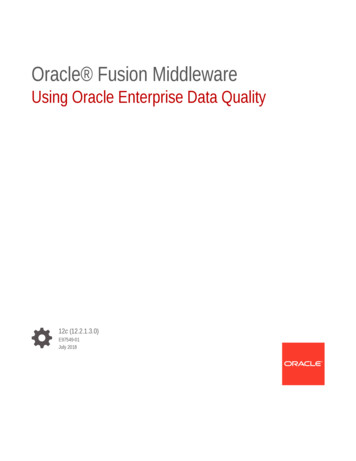
Transcription
Oracle Fusion MiddlewareUsing Oracle Enterprise Data Quality12c (12.2.1.3.0)E97549-01July 2018
Oracle Fusion Middleware Using Oracle Enterprise Data Quality, 12c (12.2.1.3.0)E97549-01Copyright 2016, 2018, Oracle and/or its affiliates. All rights reserved.This software and related documentation are provided under a license agreement containing restrictions onuse and disclosure and are protected by intellectual property laws. Except as expressly permitted in yourlicense agreement or allowed by law, you may not use, copy, reproduce, translate, broadcast, modify,license, transmit, distribute, exhibit, perform, publish, or display any part, in any form, or by any means.Reverse engineering, disassembly, or decompilation of this software, unless required by law forinteroperability, is prohibited.The information contained herein is subject to change without notice and is not warranted to be error-free. Ifyou find any errors, please report them to us in writing.If this is software or related documentation that is delivered to the U.S. Government or anyone licensing it onbehalf of the U.S. Government, then the following notice is applicable:U.S. GOVERNMENT END USERS: Oracle programs, including any operating system, integrated software,any programs installed on the hardware, and/or documentation, delivered to U.S. Government end users are"commercial computer software" pursuant to the applicable Federal Acquisition Regulation and agencyspecific supplemental regulations. As such, use, duplication, disclosure, modification, and adaptation of theprograms, including any operating system, integrated software, any programs installed on the hardware,and/or documentation, shall be subject to license terms and license restrictions applicable to the programs.No other rights are granted to the U.S. Government.This software or hardware is developed for general use in a variety of information management applications.It is not developed or intended for use in any inherently dangerous applications, including applications thatmay create a risk of personal injury. If you use this software or hardware in dangerous applications, then youshall be responsible to take all appropriate fail-safe, backup, redundancy, and other measures to ensure itssafe use. Oracle Corporation and its affiliates disclaim any liability for any damages caused by use of thissoftware or hardware in dangerous applications.Oracle and Java are registered trademarks of Oracle and/or its affiliates. Other names may be trademarks oftheir respective owners.Intel and Intel Xeon are trademarks or registered trademarks of Intel Corporation. All SPARC trademarks areused under license and are trademarks or registered trademarks of SPARC International, Inc. AMD, Opteron,the AMD logo, and the AMD Opteron logo are trademarks or registered trademarks of Advanced MicroDevices. UNIX is a registered trademark of The Open Group.This software or hardware and documentation may provide access to or information about content, products,and services from third parties. Oracle Corporation and its affiliates are not responsible for and expresslydisclaim all warranties of any kind with respect to third-party content, products, and services unless otherwiseset forth in an applicable agreement between you and Oracle. Oracle Corporation and its affiliates will not beresponsible for any loss, costs, or damages incurred due to your access to or use of third-party content,products, or services, except as set forth in an applicable agreement between you and Oracle.
ContentsPreface1AudienceviiiDocumentation AccessibilityviiiRelated DocumentsviiiConventionsviiiGetting Started With EDQ DirectorAdding a Project1-1Adding a Process1-2Adding a Snapshot1-2Adding Reference Data1-4Adding an Issue1-5Adding a Project Note1-6Adding Processors1-7About Ambiguous Latest AttributeConnecting to a Data Store1-11Configuring Fixed Width Text File Formats1-13About Files Containing No New Line CharactersExporting Data (Prepared exports)21-101-151-16About Export Options1-16Exporting Staged Data1-18Exporting Results Book1-19Running a Prepared Export1-20Running an Export Manually1-20Running an Export As a Part of a Job1-21Understanding the Key Tasks in EDQAbout Execution Options2-1About Snapshots2-1About Processes2-1About Readers2-2iii
3About Process2-3About Run Modes2-4About Writers2-6About External Tasks2-6About Exports2-7About Results Book Exports2-7About Triggers2-7Creating and Managing JobsCreating a Job3-1Editing a Job3-3Deleting a Job3-3Managing Job Canvas with Right-Click Menu3-3Editing and Configuring Job Phases3-4Using Job Triggers3-4Configuring Triggers3-5Deleting a Trigger from a Job3-6Managing Job NotificationsConfiguring a Job Notification3-7About Default Notification Content3-7Optimizing Job Performance3-10General Performance Options3-10Managing Data Streaming3-10About Minimized Results Writing3-12Disabling Sorting and Filtering3-13About Processor-specific Performance Options3-14Parsing performance options3-14Matching performance options3-15Publishing to the Dashboard43-63-18PackagingPackaging Objects4-1Filtering and Packaging4-2Opening a Package File And Importing Its Contents4-3Working With Large Package Files4-4Copying Between Servers4-4iv
5Purging ResultsPurging Match Decision Data6Creating and Managing ProcessorsCreating a Processor From a Sequence of Configured Processors6-1Setting Inputs6-2Setting Options6-3Setting Output Attributes6-5Setting Results Views6-5Setting Output Filters6-7Setting Dashboard Publication Options6-7Setting a Custom Icon6-8Customizing Processor IconsPublishing Processors86-86-9Editing a Published Processor6-10Attaching Help to Published Processors6-11Publishing Processors Into Families6-11Using Published Processors6-12About Permissions6-13Unlocking a Reference Published Processor6-13Investigating a Process75-26-13About Invalid Processor Search6-13About Input Attribute Search6-15About Clear Search Highlight6-16Previewing Published Results Views6-16Using the Results Browser6-17About Show Results in New Window6-17About Show Characters6-18Selecting Column Headers6-20Using the Event LogAbout Logged Events7-1About Server Selection7-2About Filtering Events7-2Reviewing Matching ResultsAbout Match Review8-1About Case Management8-1v
Importing Match DecisionsConnecting the Decisions Data into the Match Processor8-2Specifying the Attributes That Hold the New Decision Data8-3Mapping the Decisions Data Fields8-5Importing the Decisions8-7Exporting Match Decisions99-1Selecting Processor Options To Externalize9-1Renaming Externalized Options9-2Externalizing Match Processors9-3Selecting Match Processor Options To Externalize9-3Configuring Externalized Match Processor Options at the Process Level9-4Externalizing Jobs9-4Externalizing Snapshots9-5About Snapshot Externalization DialogExternalizing External Tasks9-69-8About External Task Externalization Dialog9-8About File Download Externalization Dialog9-9Externalizing Exports118-7Externalizing Configuration SettingsExternalizing Processor Options108-29-9Example of the Export Externalization dialog for an Access database9-10Example of the Export Externalization dialog for a Delimited Text file9-11Managing Data InterfacesAdding a Data Interface10-1Editing a Data Interface10-1Creating Data Interface Mappings10-2Deleting Data Interfaces10-3Running Jobs Using Data Interfaces10-4Configuring a Data Interface In a Job10-4Linking Processes With a Data Interface10-6Chaining Processes in a Real-Time Job10-6Example - Job containing two Data Interfaces10-7Using Case ManagementEnabling Case Management11-1vi
Publishing to Case Management12131411-1Execution TypesAbout Batch12-1About Real Time Response12-1About Real Time Monitoring12-2Publishing ResultsPublishing Result Views to Staged Data13-1About Published Results Indicator13-2Advanced FeaturesMatching14-1Clustering14-5Real-Time Matching14-11Parsing14-16vii
PrefacePrefaceThis document describes how to use Oracle Enterprise Data Quality.AudienceThis document is intended for Data Analysts or Data Stewards who are using OracleEnterprise Data Quality.Tip:Oracle recommends that the reader read this guide in conjunction with thecontent in Enterprise Data Quality Online Help.Documentation AccessibilityFor information about Oracle's commitment to accessibility, visit the OracleAccessibility Program website at http://www.oracle.com/pls/topic/lookup?ctx acc&id docacc.Access to Oracle SupportOracle customers that have purchased support have access to electronic supportthrough My Oracle Support. For information, visit http://www.oracle.com/pls/topic/lookup?ctx acc&id info or visit http://www.oracle.com/pls/topic/lookup?ctx acc&id trsif you are hearing impaired.Related DocumentsFor more information about EDQ, see the documentation set at:https://docs.oracle.comConventionsThe following text conventions are used in this document:ConventionMeaningboldfaceBoldface type indicates graphical user interface elements associatedwith an action, or terms defined in text or the glossary.viii
PrefaceConventionMeaningitalicItalic type indicates book titles, emphasis, or placeholder variables forwhich you supply particular values.monospaceMonospace type indicates commands within a paragraph, URLs, codein examples, text that appears on the screen, or text that you enter.ix
1Getting Started With EDQ DirectorThis chapter provides information on the basic operations you will perform when usingDirector.This chapter has the following sections: Adding a Project Adding a Process Adding a Snapshot Adding Reference Data Adding an Issue Adding a Project Note Adding Processors Configuring Fixed Width Text File Formats Connecting to a Data Store Exporting Data (Prepared exports) Running a Prepared ExportAdding a ProjectTo create a Project for working on a specific set or sets of data:1.From the menu, select File - New Project, or2.Right-click on Projects in the Project Browser, and select New Project:3.Follow the steps in the wizard, giving the project a Name and an optionalDescription.4.Assign the user permissions required for the new Project. By default, all usergroups will have access to the Project.The new project is created and visible in the Project Browser.You may want to Add a Note to the project to share amongst project users.1-1
Chapter 1Adding a ProcessAdding a ProcessTo add a Process to analyze data from a snapshot:1.From the menu, select File - New Process, or2.Right-click on Processes in the Project Browser, and select New Process:3.Select the Staged Data, Data Interface, Reference Data or Real time DataProvider that you want to use in the process, or do not select anything if you wantto configure the Reader in the process later.Note:It may be that you do not want to stage the data you are analyzing; thatis, you may want to stream the data directly from the source. This can bedone by selecting the Staged Data configuration, and changing theProcess Execution Preferences of the process.4.Select whether or not to add Profiling processors to the process straight away.This may be useful if you are analyzing the data for the first time.5.Give the process a Name and an optional Description.6.Click Finish.Adding a SnapshotTo add a Snapshot of data from a connected data store:1.Right-click on Staged Data in the Project Browser, and select New Snapshot:1-2
Chapter 1Adding a Snapshot2.Select the data store that you want to create the snapshot from, or add a new datastore if the desired data store is not on the list.3.Select the table or view to snapshot (or you may specify SQL to snapshot a newview of the data).4.Select the columns from the table or view that you want to include in the snapshot,and how to enable sorting and filtering on the snapshot.By default, intelligent sort and filter enablement is used. This means that resultsbased on the snapshot may be sorted or filtered using any column(s), provided thesnapshot is under a certain size (set by the system administrator). If the snapshotis above that size, results based on it cannot be sorted or filtered by any column,though users will be prompted to enable sorting and filtering on specific columns ifthey attempt to do it using the Results Browser.Alternatively, you can switch off intelligent sort and filter enablement, and manuallyselect the columns that you enable for sorting and filtering.The default threshold above which sorting and filtering will be disabled forsnapshots when using intelligent sort and filter enablement is 10 million cells - sofor example a snapshot with 500,000 rows and 15 columns (7,500,000 cells)would have sorting and filtering enabled, but a snapshot with 500,000 rows and 25columns (12,500,000 cells) would have sorting and filtering disabled.Note:It is advisable to select all columns. The columns to work with in a givenprocess can be a subset of these.5.Optionally filter the table or view to snapshot a subset of it (or you may write yourown SQL WHERE clause).6.Optionally sample the selected data (for example, the first n records, the first nrecords after an offset, or 1 record in every 100).7.Optionally perform no data normalization. For more information, see the "No DataHandling" topic in Enterprise Data Quality Online Help.8.Give the snapshot a Name, and choose whether or not to run it immediately.9.Click Finish to confirm the addition of the snapshot.The snapshot is created and visible in the project browser. It is now ready to be run(by Right-click, Run Snapshot), or used in a process and run later. The snapshot mayalso be 'streamed'; that is, used as a way of selecting the records to be processedfrom a Data Store directly; that is, without copying them into the repository.1-3
Chapter 1Adding Reference DataThe next step is Adding a Process, for example to profile the data in the snapshot.Adding Reference DataTo add a set of Reference Data to use in processors for the validation ortransformation of data:1.Right-click on Reference Data in the Project Browser, and select New ReferenceData:2.If you want the Reference Data to be a lookup onto Staged or External Data, or analternative lookup onto an existing Reference data set, rather than a new set ofData, choose New Lookup.Or, create the Reference Data using the data in the Results Browser by selectingsome data values, right-clicking and selecting Create Reference Data. Forexample, from the results of a Frequency profiler, select a results tab. Select thedesired values, right click and Create Reference Data:1-4
Chapter 1Adding an IssueNote:You can use the normal windows Shift-select, and Control-select optionsto select data. Take care not to drill down when attempting to select thedesired values. Alternatively, to select all the loaded data in the resultsbrowser for a given column, Control-select the column at the top (forexample, the Value column in the screenshot above). Press Escape tode-select all selected data.3.If you are adding new Reference Data (rather than a new Lookup onto existingReference Data), define the columns that you require in the Reference Data. Forexample, for a simple list of values, define a single column. If you would like theReference Data Editor to add a uniqueness constraint so that duplicate entriescannot be created, select the Unique? option on the column.4.Select the column or columns that you want to use when performing lookups onthe data.5.Select the column or columns that you want to use when returning values from alookup.6.Optionally, select the Category of Reference Data that you want to create, if youare creating Reference Data of a specific type (such as a list of regularexpressions).7.Give the Reference Data a Name (for example, Valid Titles) and optionalDescription (for example, 'Created from Customers table') and choose whether ornot to edit the data now.8.If you choose to edit the data now, add or delete any entries in the Reference Datausing the Reference Data Editor.9.Click OK to finish.The Reference Data set now appears under your project in the Project Browser, and isready for use in processors - for example in a List Check.Adding an IssueTo add an Issue based on your results (for example to tag an item of interest, or tocreate an action for another user to follow-up on):1.Right-click on the data in the Results Browser, and select Create Issue.:1-5
Chapter 1Adding a Project NoteNote:The issue will be linked to the specific process and processor where itwas created, so that another user can quickly find the related data.2.Add a Description of the issue.3.Optionally assign the issue to yourself or another user, and specify the Actionneeded (if any).4.Click Save to save the issue.The issue is added, and available from the Issue Manager. If the issue was assignedto another user, that user will be notified of the outstanding issue immediately, ifhe/she is logged on.Adding a Project NoteTo add a Note to a project, for example to attach a project plan, or to share some keyinformation amongst project users:1.Right-click Notes in the Project Browser, and select New Note:1-6
Chapter 1Adding Processors2.Give the note a Title.3.Add detail to the note (or leave blank if all you need is a Title, and one or moreattachments).4.Browse your file system to add a file attachment to the note (or drag and drop filesonto the indicated area).5.Click Save.The note is created and visible in the Project Browser.Adding ProcessorsEDQ comes with a library of processors for processing your data.To add a processor to your process:1.Ensure your process is open on the Canvas:2.Double-click on the Reader to configure it to read data from Staged Data (such asa Snapshot), a View, or a real time data provider.3.Select the data that you want to read, and the attributes from the data that arerelevant to your process.1-7
Chapter 1Adding Processors4.Add a processor from the Tool Palette to the process by clicking on a processorand dragging it to the Canvas.5.Connect the processor to the data from the Reader by joining the arrows:6.Configure the processor by selecting its input attributes:1-8
Chapter 1Adding ProcessorsThe blue arrow icons indicate that the latest version of the attribute will be used asthe input. This is especially important when transformation processors have beenused.See the "About Transformation Processors" topic in the Enterprise Data QualityOnline Help for further information.Note: For Profiling processors, it is common to analyze the data in allattributes to discover issues of interest about the data. Once a processor is correctly configured, it no longer appears with ablue background.7.Once you have connected the set of processors that you want to use, click on theQuick Run process button on the Toolbar to run the process and look at theresults:8.The Canvas background changes to blue to show you that the process is running.(Also, the process icon in the Project Browser turns green so that other usersconnected to the same host can see that it is running.).Note:The process is locked and cannot be edited while it is running.9.When the process has finished, the processors no longer appear with a shadedbackground, and you can browse on the results for each processor by clicking onthe processor on the Canvas, and viewing its results in the Results Browser:1-9
Chapter 1Adding Processors10. Drill-down on the metrics to see the relevant data for the metric.Having successfully created a process, you can now begin to create Reference Datafor the validation and transformation of your data.About Ambiguous Latest AttributeWhen selecting the input attributes for a processor, it is possible that some attributesmay have an ambiguous latest version. This happens whenever an attribute exists ontwo different paths, and has been transformed on either or both of these paths. Wherethis happens, the top level attribute (or latest version) will be greyed out, and will notbe selectable. In this case, you need to select the specific version of the attribute thatyou want to use by expanding on the attribute and viewing all its possible versions.For example, the Upper Case processor below has been configured with 2 input paths,from 2 different processors. The Replace processor transforms a 'title' attribute:1-10
Chapter 1Connecting to a Data StoreThe Upper Case Processor configuration would appear as follows, with the latestversion of the title attribute greyed out to indicate that it is ambiguous and therefore notavailable for use. In this case, you need to select one of the specific attributes listedunder the title attribute.This scenario will commonly occur while configuring the Merge Attributes processor,as this is often used to unite separate processing paths.Connecting to a Data StoreTo connect to a new Data Store in order to process a set of data:1.Right-click on Data Stores within your project in the Project Browser, and selectNew Data Store:1-11
Chapter 1Connecting to a Data Store2.Select the category of data store that you want to connect to - Database, Text file,XML file, MS Office file, or Other (if you want to specify connection details usingJDBC or ODBC).3.Select where the data will be accessed from - the server or the client.(See the "Client-side Data Stores" topic in the Enterprise Data Quality OnlineHelp).4.Select the type of data store that you want to connect to (for example, fordatabases, select the type of database, for example, Oracle, SQL Server, MSAccess etc.).5.Specify the connection details to the data. For example:. For a client-side Access database, browse to the .mdb file on the local filesystem. For a client-side Text file, browse to the directory that contains the text file onthe local file system. For fixed-width text files, you must also define the fieldsthat are present in the file. For a server-side file (Access, Text, Excel or XML), enter the name of thefile as it exists (or will exist) in the server landing area, including the file suffix.It is possible to use a project-specific landing area to enforce isolation betweendata in different projects. Administrators will need to setup a landing area forthe projects which require the use of this functionality. Again, for fixed-widthtext files, you must also define the fields that are present in the file.6.For a Database, specify the Database host, Port number (if not using the defaultport number), Database Name, User Name, Password, and Schema (if differentfrom the default Schema for the User).7.For a database accessed via a JNDI connection, specify the JNDI name.8.For any other type of data that can be accessed via an ODBC bridge connector,specify the ODBC DSN, JDBC URL, User name and Password.9.For any Other type of data that can be accessed via JDBC, specify the DriverClass Name, JDBC URL, User name and Password.10. If you want to check the connection to the new data store, use the Test button.Note that it is possible to specify connection details to a file that is not yet present(such as a file to be created by an export task in EDQ).Note:Connecting non-native types of data source requires some knowledge ofJDBC connectivity.11. Give the data store a Name, and click Finish.The new data stories are now configured and visible in the Project Browser.1-12
Chapter 1Configuring Fixed Width Text File FormatsAlternatively, if the data store is going to be shared across projects, you can create itat the System level (outside of any specific project) in the same way as above.The next step is Adding a Snapshot of data from your data store.Configuring Fixed Width Text File FormatsWhen you define a new data store that connects to a fixed width text file, the NewData Store wizard will prompt you to define the names and sizes of the data fields inthe file.Data in a fixed-width text file is arranged in rows and columns, with one entry per row.Each column has a fixed width, specified in characters, which determines themaximum amount of data it can contain. No delimiters are used to separate the fieldsin the file. Instead, smaller quantities of data are padded with spaces to fill the allottedspace, such that the start of a given column can always be specified as an offset fromthe beginning of a line. The following file snippet illustrates characteristics common tomany flat files. It contains information about cars and their owners, but there are noheadings to the columns in the file and no information about the meaning of the data.In addition, the data has been laid out with a single space between each column, forreadability:In order to parse the data in a fixed width text file correctly, EDQ needs to be informedof the column sizes implicit in that file. This is done in the New Data Store wizard, andcan be edited as part of the data store settings later, if required.When you first enter the data store configuration screen for a fixed width text file, thecolumns table is empty. In the following screenshot, it has been populated with themapping information for some of the columns in our sample file:1-13
Chapter 1Configuring Fixed Width Text File FormatsEach column is described to EDQ by its starting position and width, in characters.Each column is also assigned a name, which is used in data snapshots anddownstream processing so that the data can be identified. Names are defined by theuser at the time the data store is defined and should be descriptive, for maximumdownstream usability.Notice that the positions of the data columns are defined in terms of start point andwidth. Note also that the first character on a line is at position 1, not zero. Providing awidth and a starting point for each column means that EDQ does not assume that onecolumn continues right up until the start of the next, with the result that: Any spaces that have been included in the file for readability, such as a singlespace between columns, can automatically be bypassed. It is not necessary to define mappings for every column in the file. If un-neededcolumns exist, they can simply be omitted from the column definitions in the datastore configuration. For example, we have not included the third column from thefile in our mappings, but because the boundaries of the surrounding columns aretightly defined, no extraneous data will be included in the data set. Columns do not have to be specified in the same order as they occur in the file.The column order specified here will be reflected in any snapshots created fromthe data source.The buttons to the right of the columns table can be used to add or remove records, ormove the selected record up or down in the list.1-14
Chapter 1Configuring Fixed Width Text File FormatsAbout Files Containing No New Line CharactersBy default, it is assumed that fixed width files will be formatted as already described,with a new line separating one row from the next. However, some files do not use newline characters to separate rows. Data will then appear like this in a text editor:In this case, the width of the whole record must also be specified as part of the datastore configuration, so that EDQ can correctly subdivide the data into rows. To do this, Check the Fixed width records checkbox underneath the columns table, and Specify the total record size, in characters, in the Record size box:1-15
Chapter 1Exporting Data (Prepared exports)Exporting Data (Prepared exports)There are two sources of data for prepared exports: Data from Staged Data and datafrom Results Books.Note:It is also possible to create an ad-hoc export to Excel directly from theResults Browser.About Export OptionsThe Export Task defines the source and shape of the data that will be exported, andthe target for the export (such as an output text file, an existing table in a database towhich the data is mapped, or a new table in a database).The user chooses how the Export behaves when adding the Export Task to a job:1-16
Chapter 1Exporting Data (Prepared exports)The options are: Delete current data and insert (default): EDQ deletes all the current data in thetarget table or file and inserts the in-scope data in the export. For example, if it iswriting to an external database it will truncate the table and insert the data, or if itis writing to a file it will recreate the file. Append to current data: EDQ does not delete any data from the target table orfile, but adds the in-scope data in the export. When appending to a UTF-16 file,use the UTF-16LE or UTF-16-BE character set to prevent a byte order markerfrom being written at the start of the new data. Replace records using primary key: EDQ deletes any records in the target tablethat also exist in the in-scope data for the export (determined by matching primarykeys) and then inserts the in-scope data.1-17
Chapter 1Exporting Data (Prepared exports)Note: When an Export is run as a standalone task in Director (by right-clickingon the Export and selecting Run), it always runs in Delete current dataand insert mode. Delete current data and insert and Replace records using primarykey modes perform Delete then Insert operations, not Update. It ispossible that referential integrity rules in the target database will preventthe deletion of the records, therefore causing the Export task to fail.Therefore, in order to perform an Update operation instead, Oraclerecommends the use of a dedicated data integration product, such asOracle Data Integrator.Exporting Staged DataOnce a Staged Data table has been created with a Writer processor, an Export to writeit to a Data Store can be created. The Export may then be manually run, or executedwhen the process that generates the Staged Data table is run.To set up an Export of a Staged Data table:1.Right-click on Exports in the Project Browser, and select New Export.:2.Select the required Staged Data table.3.Select the required Data Store.4.If the table in the Data Store is not being created during export, select the requiredtable in the Data Store.Note:The contents of this table will be overwrit
This document is intended for Data Analysts or Data Stewards who are using Oracle Enterprise Data Quality. Tip: Oracle recommends that the reader read this guide in conjunction with the content in Enterprise Data Quality Online Help. Documentation Accessibility For information about Oracle's commitment to accessibility, visit the Oracle



